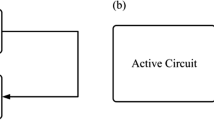Conclusions
-
1.
The minimum period of the effectively suppressed frequency variations is determined by the water inertia of the penstocks and amounts to about 20 TW. Hence, in the construction of a hydroelectric plant with an increased penstock inertia it is necessary to take into account not only its specific share in the power system, but also the periodicity of the frequency variations in the power system, as well as the presence of other hydroelectric plants with low values ofT W capable of suppressing the quick frequency variations.
-
2.
The lag in output from the hydraulic unit with respect to the initial displacement of the turbine control amounts to about 1.5 TW; hence, as TW increases, the effectiveness of the participation of the hydroelectric plant in the limitation of the power exchanges decreases, and for TW=4–5 sec it cannot suppress the minute variations in the power exchanges. This circumstance should be taken into account in the establishment of the operating regimens of the hydroelectric plant in the power system.
-
3.
In selecting a hydraulic unit as emergency reserve, the basic index of its time response should be the equivalent time lag of the output, whose allowable value can be calculated for the specific power system from the condition of prevention of drop of the frequency to the setting of the first category of the frequency unloading.
Similar content being viewed by others
Literature Cited
Norms for Technical Design of Hydroelectric Plants [in Russian], Énergiya, Moscow (1970).
G. I. Krivchenko, “Dynamic regulating characteristics of the units of hydroelectric plants,” Élektricheskie Stantsii, No. 7 (1967).
A. B. Barzam, System Automation [in Russian], Énergiya, Moscow (1973).
Automatic Regulation of Power Exchanges through Inter-system Lines. Collection of Articles [in Russian], Énergiya, Moscow (1965).
V. Oii, “Use of frequency methods for analyzing the process of turbine regulation in a power system in Sweden,” in: Frequency Methods in Automation [Russian translation], Inostrannaya Literature, Moscow (1957).
G. I. Krivchenko, Automatic Regulation of Hydraulic Turbines [in Russian], Énergiya, Moscow (1964).
Additional information
Translated from Gidrotekhnicheskoe Stroitel'stvo, No. 4, pp. 33–35, April, 1974.
Rights and permissions
About this article
Cite this article
Kiselev, G.S. Effect of water inertia in penstocks on regulating characteristics of hydraulic units. Hydrotechnical Construction 8, 337–341 (1974). https://doi.org/10.1007/BF02406941
Issue Date:
DOI: https://doi.org/10.1007/BF02406941




